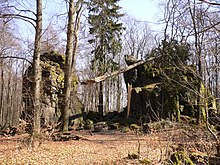Place of worship
As a place of worship or place of worship , a ge is heiligter , often geographically distinctive place designated, at which a cult was practiced or. The term place of worship is primarily used for places and structures from prehistory and early history as well as places of cultic significance by followers of ethnic religions . Religious buildings of book religions , especially Christian ones, are usually called sacred buildings . Sometimes religious buildings such as chapels and churches or even settlements were built at old places of worship in later times.
Places of worship are often connected to burial sites or served as a tomb for a politically and religiously significant person. In some sacred places, ritual acts are still carried out in the present (e.g. services on Christian holidays).
Natural conditions and design by human hands
As a rule, places of worship are outstanding places in nature that, according to an associated legend, were often “found” magically. Often these are places where, according to mythical tradition, earth deities have come to the surface and have made themselves known in caves or waterfalls, on mountain peaks or trees. Some of them were later taken over by a newly introduced monotheistic religion, given new names and given different iconographic features.
In the course of designing a place of worship, it was customary to carry out structural measures that increasingly gave the place of nature, which is considered to be sacred, a character designed by human hands. Often a dark interior was delimited from an open continuum. Depending on the extent of the overbuilding, places of worship are shaped more by the natural conditions or predominantly by the formation of human hands. In some cases there are demarcated areas such as enclosures, ditches, walls, stone circles or ramparts that have been designed by humans .
Cult places shaped by the natural conditions are holy mountains , rock sanctuaries, holy stones, high altitude sanctuaries , summit sanctuaries or grotto sanctuaries as well as holy islands ( Heligo Land = Heligoland, Holy Island near Anglesey , Holy Isle in front of the Isle of Arran , Inish Cealtra in Lough Derg in Ireland), sacred springs with associated places of worship ( Roseninsel , Sylt ) or caves, lakes, forests and moors. Prominent trees or places marked by them, such as sacred groves, could also characterize a place of worship. Often the name given to the former character as a place of worship is recognizable (for example Odense = 'Odin's lake'; Thorslund = 'Thor's forest'). The natural cult sites that have been changed or expanded by human hands include the Externsteine , numerous nymphaeans or the summit of the Puy de Dôme , on which a temple of Mercury was built in ancient times .
In individual cases, a cult site can be separated from its surroundings by barriers (so-called taboo zones ) that are anchored in the knowledge of the user. The stones of the megalithic complexes , slabs, columns or steles had different cultic functions. For example, they served as an altar , to visualize the dead or to represent various deities. Megalithic sites such as Stonehenge in England, Maltese temples and temples such as Karnak in Egypt became famous .
literature
- Matthias Egeler (ed.): Germanic cult sites. Comparative, historical and reception-historical approaches (= Munich Northern Studies 24). Utz, Munich 2016.
- Giesela Graichen: The cult place book. A guide to the old places of sacrifice, shrines and places of worship in Germany. Hoffmann and Campe, Hamburg 1988, ISBN 3-455-08282-3 .
- Anders Hultgård : Religion. In: Reallexikon der Germanischen Altertumskunde . Volume 24, de Gruyter, Berlin / New York 2003, ISBN 3-11-017575-4 , pp. 429–457, here: 442–445.
- Elisabeth Neumann-Gundrum: Europe's culture of large sculptures. Wilhelm Schmitz, Giessen 1981, ISBN 3-87711-039-8 .
Web links
Individual evidence
- ↑ Horst W. Müller: Wilhelmsteine and Ellerchen, legendary and strange stones and rocks in the south-western hinterland , Hinterland history sheets, Biedenkopf, 93rd year, No. 3, September 2014.
- ^ Niels Gutschow : Kultort / Kultbauten. In: Christoph Auffarth et al. (Ed.): Dictionary of Religions , Stuttgart 2006, p. 299.

